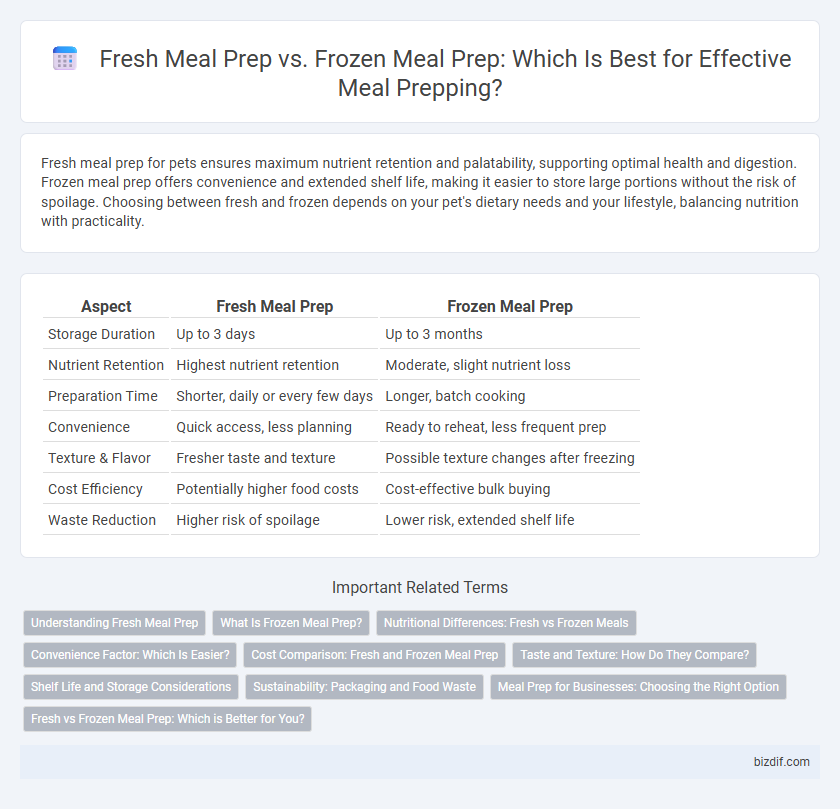Fresh meal prep for pets ensures maximum nutrient retention and palatability, supporting optimal health and digestion. Frozen meal prep offers convenience and extended shelf life, making it easier to store large portions without the risk of spoilage. Choosing between fresh and frozen depends on your pet's dietary needs and your lifestyle, balancing nutrition with practicality.
Table of Comparison
| Aspect | Fresh Meal Prep | Frozen Meal Prep |
|---|---|---|
| Storage Duration | Up to 3 days | Up to 3 months |
| Nutrient Retention | Highest nutrient retention | Moderate, slight nutrient loss |
| Preparation Time | Shorter, daily or every few days | Longer, batch cooking |
| Convenience | Quick access, less planning | Ready to reheat, less frequent prep |
| Texture & Flavor | Fresher taste and texture | Possible texture changes after freezing |
| Cost Efficiency | Potentially higher food costs | Cost-effective bulk buying |
| Waste Reduction | Higher risk of spoilage | Lower risk, extended shelf life |
Understanding Fresh Meal Prep
Fresh meal prep emphasizes using seasonal, nutrient-dense ingredients prepared shortly before consumption to maximize flavor and retain vitamins. This method supports a varied diet by allowing customization of meals based on daily preferences and reduces the need for preservatives or additives. Preparing fresh meals daily or every few days ensures optimal texture, taste, and nutritional benefits compared to freezing.
What Is Frozen Meal Prep?
Frozen meal prep involves preparing meals in advance and storing them in airtight containers that are then kept in the freezer to maintain freshness and nutritional value. This method allows for extended shelf life, convenience, and reduced food waste compared to fresh meal prep, which typically requires consumption within a few days. Popular frozen meal prep options include soups, casseroles, and portioned proteins, all designed for quick reheating without compromising flavor or texture.
Nutritional Differences: Fresh vs Frozen Meals
Fresh meal prep retains higher levels of certain heat-sensitive nutrients like vitamin C and folate, while frozen meal prep preserves most nutrients due to rapid freezing processes that minimize nutrient loss. Frozen meals can sometimes contain added sodium or preservatives to maintain flavor and texture, which may affect overall nutritional quality compared to fresh meals. Both approaches offer convenient, balanced options, but fresh meals generally provide superior nutrient density and fewer additives.
Convenience Factor: Which Is Easier?
Fresh meal prep offers ease through minimal reheating and immediate consumption, making it ideal for those prioritizing quick access to healthy meals. Frozen meal prep requires longer preparation time with thawing and reheating but allows for bulk cooking and extended storage, providing convenience for long-term planning. Choosing between fresh and frozen meal prep depends on individual schedules and lifestyle demands centered around convenience and time management.
Cost Comparison: Fresh and Frozen Meal Prep
Fresh meal prep often incurs higher costs due to the need for frequent grocery shopping and potential food waste from perishables. Frozen meal prep reduces expenses by allowing bulk purchases, extended shelf life, and minimized spoilage, making it more budget-friendly. Comparing average weekly costs, fresh meal prep can range from $40 to $70, whereas frozen options typically fall between $25 and $50, highlighting significant savings.
Taste and Texture: How Do They Compare?
Fresh meal prep preserves vibrant flavors and maintains optimal texture by avoiding the freezing process, resulting in crisp vegetables and tender proteins that retain their natural juiciness. Frozen meal prep can slightly alter taste and texture due to ice crystal formation, often causing vegetables to become softer and meats to lose some moisture during thawing. However, proper freezing techniques like flash freezing help minimize these effects, allowing frozen meals to approach the quality of fresh-prepped dishes.
Shelf Life and Storage Considerations
Fresh meal prep typically offers a shelf life of 3 to 5 days when stored in airtight containers in the refrigerator, maintaining optimal taste and nutrient quality. Frozen meal prep extends shelf life significantly, ranging from 1 to 3 months depending on the ingredients and packaging methods, though some textures and flavors may alter after thawing. Proper storage considerations include using vacuum-sealed bags for freezing to prevent freezer burn and labeling containers with dates to manage freshness effectively.
Sustainability: Packaging and Food Waste
Fresh meal prep often uses minimal packaging, reducing plastic waste and promoting the use of reusable containers, which supports sustainable consumption. Frozen meal prep typically involves sealed packaging that can contribute to single-use plastic waste, but it helps minimize food waste by preserving ingredients longer and allowing portion control. Balancing packaging impact with food preservation benefits is crucial for sustainable meal prepping strategies.
Meal Prep for Businesses: Choosing the Right Option
Businesses must evaluate factors such as storage capacity, shelf life, and customer preferences when choosing between fresh meal prep and frozen meal prep. Fresh meal prep offers higher nutritional value and immediate consumption appeal, while frozen meal prep extends product lifespan and simplifies inventory management. Selecting the right option enhances operational efficiency and meets market demands in the food service industry.
Fresh vs Frozen Meal Prep: Which is Better for You?
Fresh meal prep retains more nutrients and offers better texture and flavor compared to frozen options, which can sometimes lose vitamins during freezing and thawing. Frozen meal prep, however, provides convenience and longer shelf life, making it ideal for those with busy schedules or limited time for cooking. Choosing between fresh and frozen meal prep depends on dietary priorities, lifestyle, and meal planning preferences to maximize health benefits and food quality.
Fresh Meal Prep vs Frozen Meal Prep Infographic

 bizdif.com
bizdif.com